光·迹 —— 陈开 & 布拉德·布朗
Shimmer and Stain: Chen Kai and Brad Brown
上海狮語画廊 Leo Gallery Shanghai
艺术家|Artists
布拉德·布朗 Brad Brown
陈开 Chen Kai
展期|Duration
2023.09.23-10.29
地点|Venue
武康庭|上海徐汇区武康路376号,狮語画廊
Ferguson Lane|Leo Gallery, 376 Wu Kang Road, Xuhui District, Shanghai
Scroll down for English
连续的世界、相邻的绘画
—— 展览《 光·迹 —— 陈开 & 布拉德·布朗》
文/于潍颖

布拉德·布朗 Brad Brown
《Piece 454 (错误的风景)》 Piece 454 (Faulty Landscape)
2019
木板油画、胶合板、胡桃木墨水、钢丝钉
Oil, Plywood, Walnut Ink, Wire Brads on Cradled Panel
48.3 x 48.3cm
阳光穿过迷雾洒落在旧金山的海湾, 越过广阔的太平洋, 千重浪的另一岸是上海缓流入海的黄浦江与苏州河。布拉德·布朗(Brad Brown)与陈开的抽象绘画创作在旧金山与上海并行、交汇、构成流动的对话。他们的系列绘画创作是画布上的时间累积与视觉档案、是笔触与颜料间流淌的诗意与想象力的有机物。
布拉德·布朗于1987年开始创作他的纸本绘画系列“The Look Stains”,于2001年开始创作木板油画“Piece”, 并且至今保持“未完成”的状态。不再龃龉于“完成”与“未完成”的二元对立, 画家的日常创作所生成的变化如植物般生机盎然地生长。系列中上千幅画作编织成一张视觉信息网络, 通过装订、剪贴、重组变化着形态。它们如同连环画或幻灯片, 每幅画作中的事物以奇妙地方式产生关联、轻柔地说笑。之于布拉德·布朗, 他的画作之间相互独立,但从不孤单。

布拉德·布朗 Brad Brown
The Look Stains (4298-4382), 2021
纸本油彩, 木炭, 石墨, 钢笔与墨水
Oil, Charcoal, Graphite, Pen and Ink on Paper
193 x 193cm
陈开的布面丙烯绘画不仅局限于大尺幅抽象画作所展现的崇高感, 更为明晰的是, 点彩绘画和对细节的体验是画家与画作材料产生情感驱动的一部分。在“重复与差异”中, 重复是新, 是细微的差别、也是超越基础规则的尝试。点彩画的笔触与变幻的色块之间是游牧式的流动与安营。陈开曾在旧金山湾区附近的萨利托(Sausalito)海岸国家公园进行了一年的艺术家驻留项目, 工作室窗外, 毗邻太平洋的晨昏雾霭, 风中摩挲舞蹈的桉树, 成为记忆流转于画布上层叠的光影。
无论是布拉德·布朗根茎般生长的画作,还是陈开非中心化的“星图”, 都指向艺术对人内心世界与日常生活的表达与突破。你可以理解一幅画, 而无需知道它被固然定义为何。
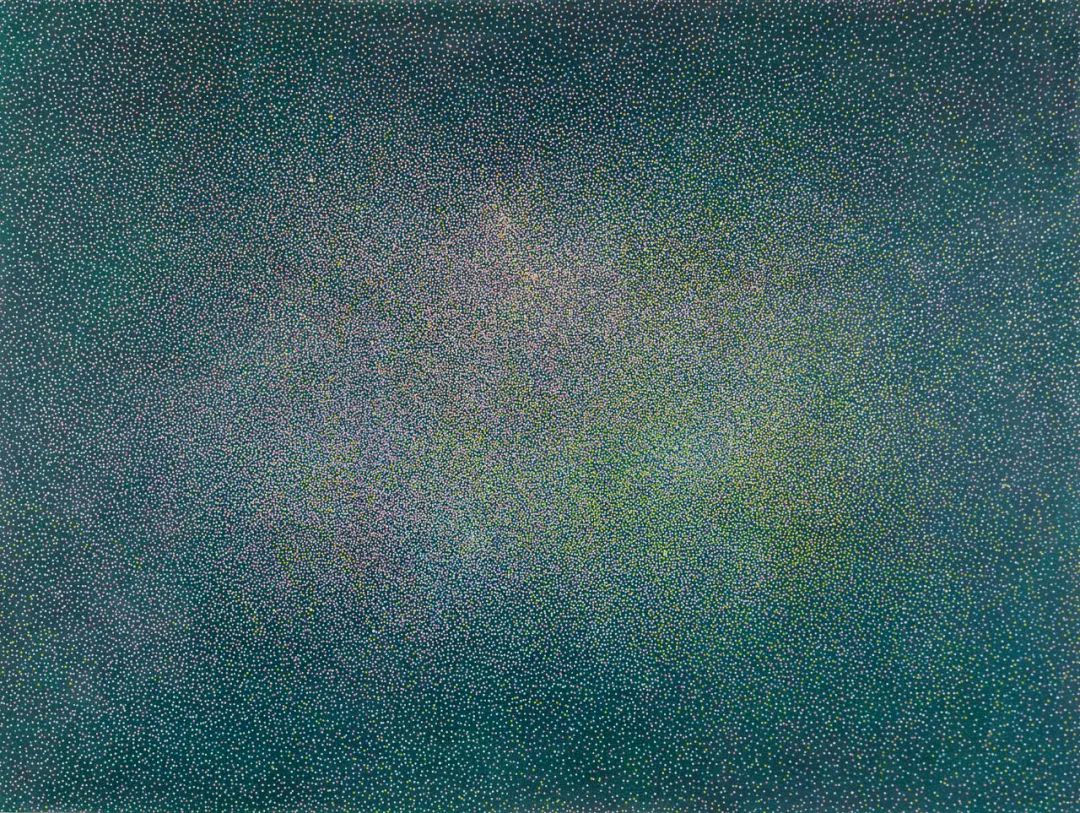
陈开 Chen Kai
《科西嘉之星》 The Corsican Stars, 2023
150 x 200 x 4cm
布面丙烯
Acrylic on Linen
局部·星尘
布拉德·布朗的画作大多是小尺幅的木板油画系列或版画。经过数十年的连续创作累积, 几千幅画作之间产生着动态地视觉互文。在名为“Piece”的木板油画系列中, 每幅画作的局部之间彼此成为伙伴, 越过画框的边界互相致意。这些抽象的形象是日常的事物(蘑菇、鸟、人物), 也充满寓言的象征(微表情、时间、恶魔)。画面中的抽象形态流露着米罗(Joan Miró)般的稚气未脱、纯真游离; 日常中任何物体都能够自由行走、变幻形态。细窄的画框与每幅画的主色调相协调, 成为画作的一部分, 画面空间的边界在消失、移动、融合。布朗用“stain”来代表他长期以来的绘画系列。stain译为污渍或斑迹, 它们不对美做诠释, 而是日常生活所赋予的动感和生命力。它们像是画室中颜料不经意在地板或任何地方洒下的斑点, 也可以存在于画框之外, 自然地留存或消逝。布朗对抽象绘画的内容与形式或许像他喜欢的一位诗人罗恩·帕特(Ron Padgett)对生活意象的传达: 帕特的诗总以简洁词语和平实的语调透露平凡生活里日常的瞬间、无望中的希望、孤独间的自由。
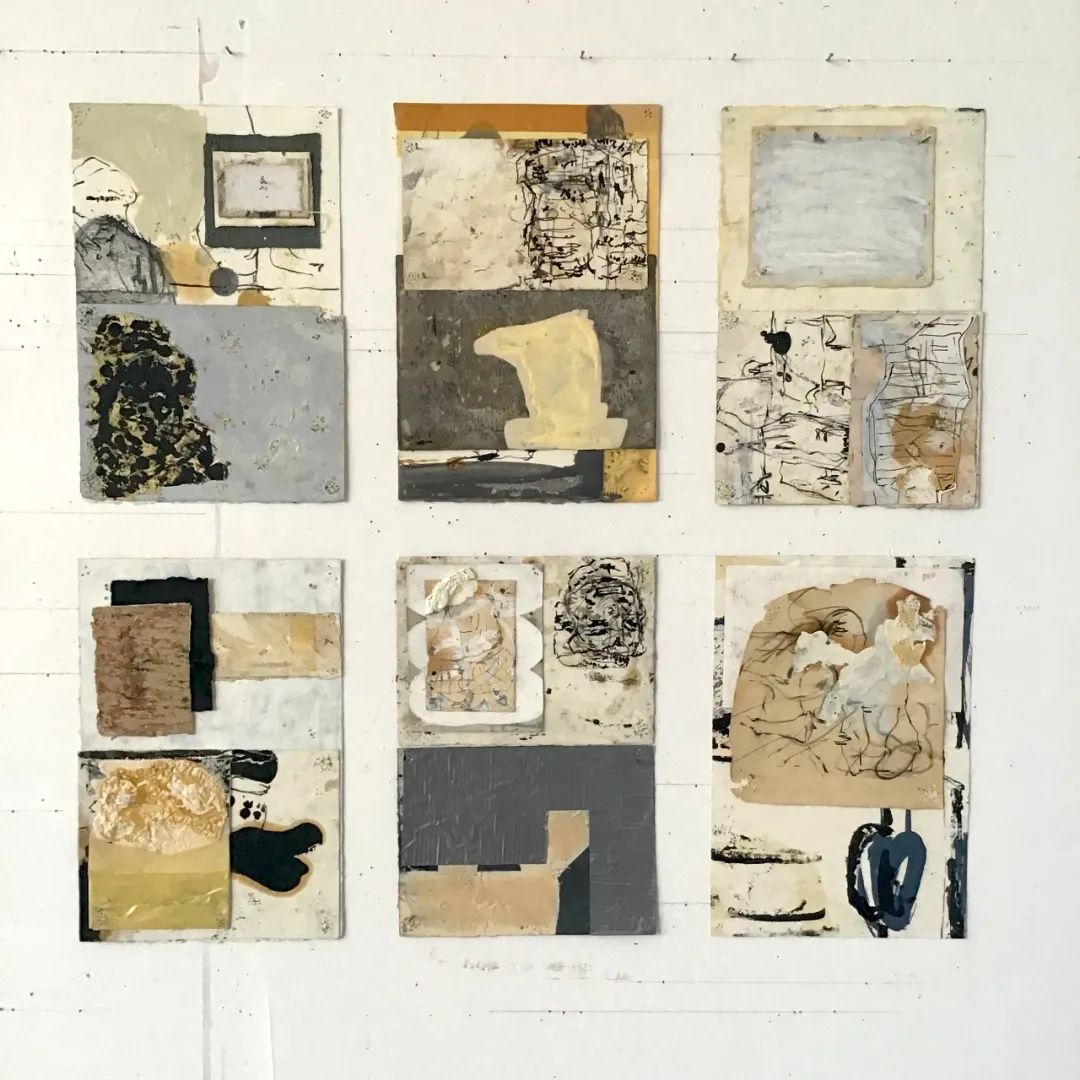
布拉德·布朗 Brad Brown
The Look Stains (4177-4195), 2021
纸本油彩, 木炭, 石墨, 钢笔与墨水
Oil, Charcoal, Graphite, Pen and Ink on Paper
94 x 91.4cm
布拉德·布朗曾长期于旧金山艺术学院(San Francisco Art Institute, 简称SFAI)绘画系任教。SAI于1871年建校, 主校区位于俄罗斯山街区的栗子街800号, 是美国历史上最为悠久的现当代艺术学院之一, 乌托邦式地延续着纯艺术教育。SFAI校园建筑的一部分为意大利与西班牙殖民风格, 另一部分是英国建筑师Paffard Keatinge-Clay设计的现代主义风格。塔楼、拱廊、马赛克喷泉与延展向海湾的露台、望向天际的锥形混凝土天窗, 共同诠释着旧金山交融而迷幻的气质。SFAI记录了二战前后当代艺术在美国的蓬勃发展、兴盛与演变以及一个艺术家群星闪耀的时代。在近150年的校史中, 安塞尔·亚当斯(Ansel Adams)于1945创立了艺术摄影系; 亨利·马蒂斯(Henri Matisee)、马克·罗斯科(Mark Rothko)、约翰·凯奇(John Cage)等艺术家造访、举办讲座或任教于此。艺术流派与新的尝试在加州西海岸不断出现, 从抽象表现主义到摄影现实主义、波普、极简以及具象画派, 如同迭戈·里维拉(Diego Rivera)在SFAI校园创作的室内壁画《展现城市建设的壁画》(The Making of Fresco Showing the Building of a City, 1931)所描绘的那样: 脚手架上设计师、工程师、艺术家、工人共同建造开启一个城市的历史和未来; 同时另一面, 在资本的旋涡中(1929-1933的大萧条), 艺术如何成为看到个体的劳动和搭建生活希望的脚手架。
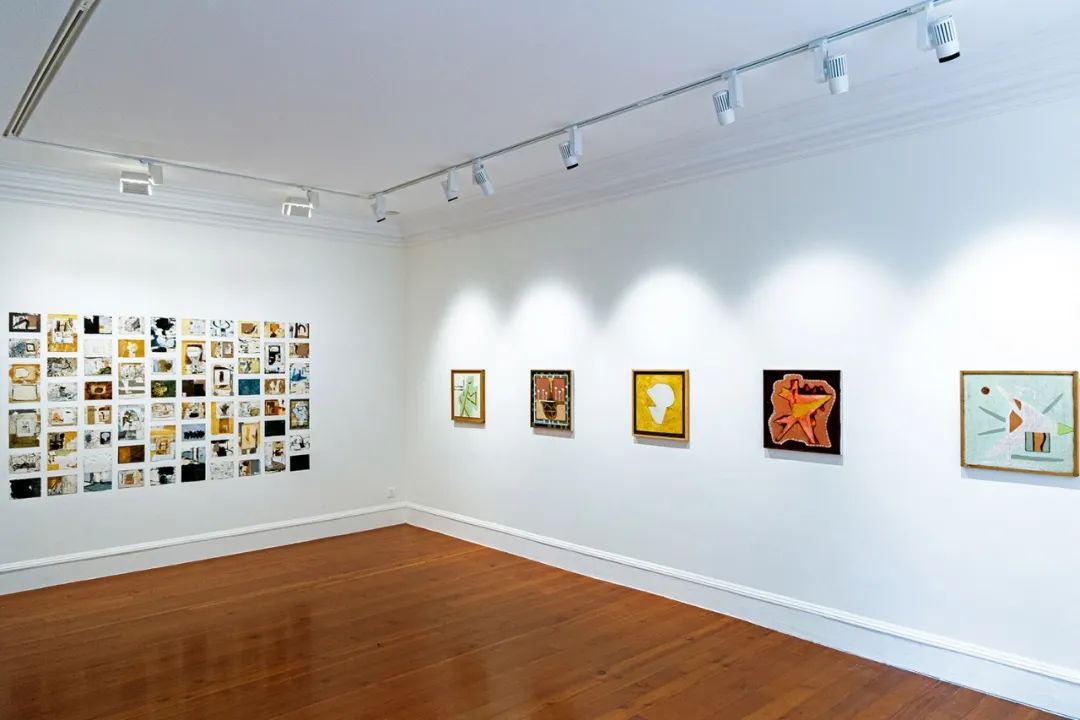
展览现场 Installation View
旧金山的海湾风景对画家们有着独特的感染力: 万物的色彩在灿烂明丽的阳光下如此饱满。在SFAI, 布拉德·布朗与陈开成为师生, 讨论绘画创作的方法与理念。更确切地说, 作为画家, 面对一幅画和其发展的可能性, 需要问的是, “这是你想要的吗?”
陈开的抽象画作交汇于“光、色彩、自然与宇宙”之中。在画作《最后的光》(Last Light)中,黑色打底的画布上, 无数散落铺陈的黄色点彩画域既是金色日光的温暖, 同时也意涵人造光源的视觉温暖。画作的题目致意了菲利克斯·冈塞雷斯·托雷斯(Felix Gonzalez-Torres)的同名装置作品。两者共同表达了希望和陪伴在现实重力中的闪现: 一串灯泡的暖光与星夜的光是色彩温度所寄与的温柔情感。而作品《最初的光》(First Light)的点彩构成更为复杂: 灰色、紫灰色、黄灰色以及蓝灰色。黑暗与光线在轮替与交界, 如果宇宙与死亡的基底是永恒的黑色, 光线与其反射的种种是人类感知自然万物存在、空间、自我的基本方式。大尺幅的抽象画作在时间与精力的投入外, 是对一层层画面铺陈的重复、把握与判断。尺度成为容纳画家创作的界面, 同时也被继续分隔、再现与重组。而每种色彩或色块所产生的力量都在缓缓地爆发出新的疆域。使用点彩画的笔触与技法, 层叠的色点不再描绘具象的轮廓, 而是成为情感地图的坐标。陈开的画作中, 整体的色彩具有聚集能量的力度, 同时点彩的画法也在瓦解所有具有中心的意象。点彩画的技法与抽象表象主义所展现的色彩, 如同旋涡或河流吸引观者的注意力。技法之上的审美表达,是密度与色彩所抵达纯粹情感的居所。
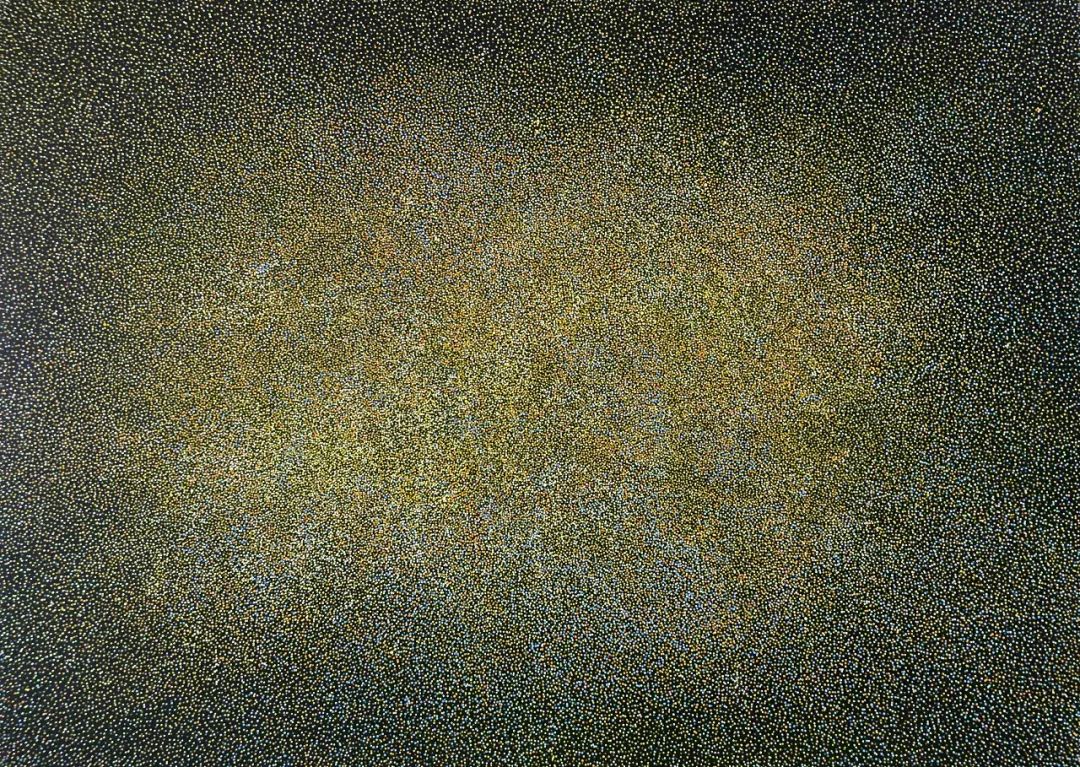
陈开 Chen Kai
《最后的光》 Last Light, 2023
150 x 200 x 4cm
布面丙烯
Acrylic on Linen
绘画的空间: 画面、画室、展览
如同陈开在旧金山艺术学院学习绘画, 在海德兰艺术中心(Headlands Center For the Arts)艺术家驻地项目发研习和展系列创作; 2023年, 布拉德·布朗受邀来到上海的驻地空间进行创作。大洋的两岸, 他们或许有各自对地景和文化陌生感的体验和全新表达, 也将再次成绘画中的抽象元素, 成为画家之间友谊的延续。画面承载的信息与信念是画家主体性的表现。画面本身是创造的载体, 而画面传达的感受与引发的感情无法被占有, 而是在下一段过程中得到延续, 保持“未完成”的状态。画室作为画家创作的日常空间, 也是一种“港湾”的存在——抽象中构造秩序、拥抱混乱或丰富。从画室到展览空间, 观众对绘画的观看激发或唤醒不同个体的主体性。在绘画的空间里, 世界仍是实际可以感触的: 布拉德·布朗与陈开的近期绘画创作提供了关联但又迥异的一种共鸣, 内容和形式的丰富、拥抱有趣而温柔的情感。

开幕现场 Opening View
Unfinished Space, Fellowship of Painting
–Shimmer and Stain: Chen Kai and Brad Brown
——
Text by Yu Weiying
Sunlight pours through the mist on San Francisco Bay, illuminating the vast Pacific Ocean. On the other side of the waves lie Shanghai's Huangpu and Suzhou River, which flow tranquilly into the sea. Brad Brown and Chen Kai's abstract paintings engage in a fluid dialogue between San Francisco and Shanghai. Their series of paintings represent an accumulation of time, the painters’ visual archives on canvas, and organisms of poetry and imagination that flow between brushstrokes and colors.
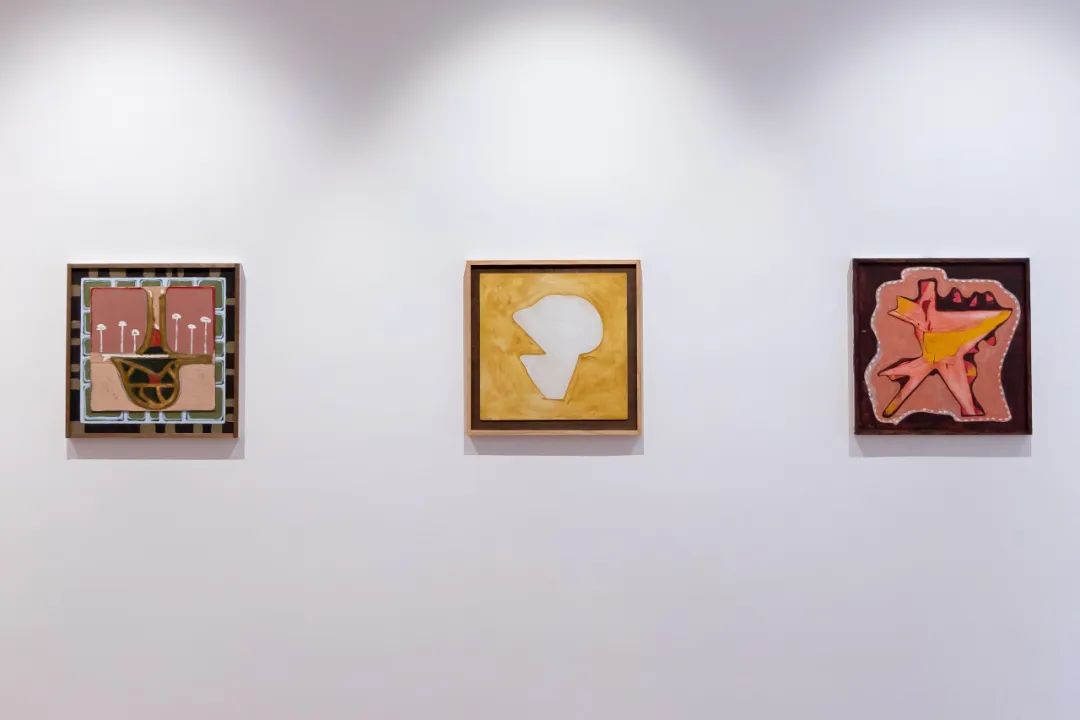
展览现场 Installation View
Brad Brown began his series of works on paper, The Look Stains, in 1987; and a body of oil paintings on cradled panels titled, Piece, in 2001. Both projects have remained “unfinished” ever since. No longer restricted by the dichotomy between the states of "completed" and the "not completed", the artist's daily creations grow and thrive like plants with vitality. The series comprises thousands of paintings arranged into a network of visual information that undergoes constant transformation through the painter's assembling, cutting, pasting, and reorganizing. The objects in each painting are splendidly connected and interact with each other like a comic strip or slide show. Each of Brown's paintings is independent, yet never alone.

开幕现场 Opening View
Chen Kai's paintings go beyond the sense of sublime arising from large-scale abstraction. What stands out is Chen’s persistence in experiencing details through pointillism, which partially provokes the painter’s emotion towards his painting materials. In “repetition and difference,” the “repetition” highlights novelty, nuance, and an attempt to go beyond the ground rules. Nomadic flow exists between brushstrokes and shifting colors in pointillism. Chen Kai spent a year in an artist-in-residency program at the Marin Headlands in Sausalito near San Francisco where he could view morning mists, the gentle twilight of the Pacific Ocean, and eucalyptus trees dancing in the wind from his studio window. These eventually transformed into layers of light and shadows on his canvas.
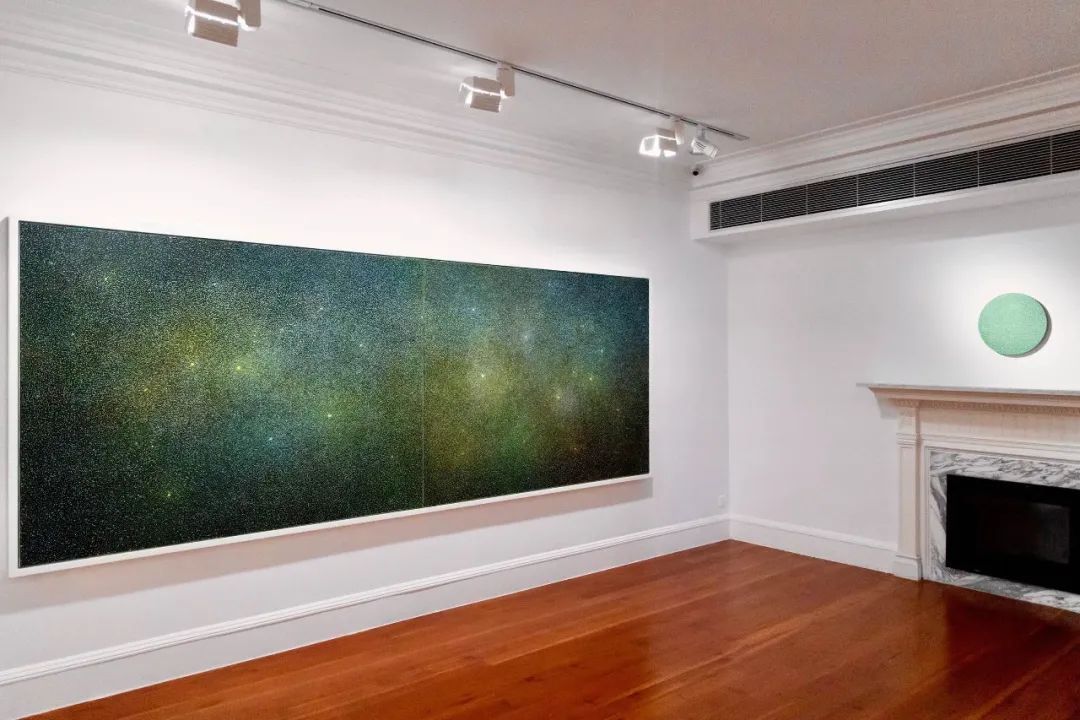
展览现场 Installation View
Whether it's Brad Brown's paintings, which grow like rhizomes, or Chen Kai's paintings, scattered like "starry nights", they all ultimately lead to the expression of one's inner world and a breakthrough from mundane life. You can appreciate a painting without necessarily knowing how it's defined.
Piece Stardust
Brad Brown's paintings are mostly small-scale oil on wood panel series or prints. After decades of continuous creation, thousands of paintings have generated dynamic visual inter-texts. In the series of oil paintings on wood panel titled Piece, different parts of the painting are partnered with each other, referencing each other across the borders of their frames. These abstract images are of everyday objects (mushrooms, birds, people), but also full of allegorical symbols (micro-expressions, time, demons). The abstract forms in the painting are similar to the childishness and innocence of Joan Miró’s works; any object in daily life can move freely and change its shape. The narrow frames are in harmony with the primary color of each painting and thus become a part of the paintings. The boundaries of the image constantly disappear, move, and merge. Brown uses the word "stain" to represent his long-running series of paintings.Although "Stain" is translated as "taint" or "marks" in Chinese, it does not seek to convey the concept of beauty. Instead, it captures the essence of movement and vitality found in everyday life. These stains are akin to random paint splatters on the floor or in the studio. They can also exist outside the frame, naturally remaining or disappearing. Brown's abstract paintings, both in terms of content and form, may be similar to how one of his favorite poets, Ron Padgett, represents life. Padgett's poems use concise words and plain tones to capture the mundane moments in ordinary life, the hope in despair, and the freedom in loneliness

布拉德·布朗 Brad Brown
《Piece 574 (意大利人)》 Piece 574 (The Italian)
2012-2021
木板油画、钢丝钉
Oil, Wire Brads on Cradled Panel
25.4 x 21.6cm
Brad Brown has served as a Richard C. Diebenkorn Teaching Fellow at the San Francisco Art Institute (SFAI). Established in 1871, SFAI is one of the oldest schools of modern and contemporary art in the United States. The main campus is located at 800 Chestnut Street in the Russian Hill district. The institute offers fine arts education and fosters a utopian art community. Parts of the SFAI campus architecture are in Italian and Spanish colonial style, while other parts are in the modernist style designed by British architect Paffard Keatinge-Clay. The campus features towers, arcades, mosaic fountains, terraces extending toward the bay, and tapered concrete skylights that collectively embody the ever-changing psychedelic temperament of San Francisco. SFAI records the vigorous development, prosperity, and evolution of contemporary art in the United States before and after World War II, an era when artists were shining brightly. In the nearly 150 years of the school’s history, Ansel Adams founded the Department of Art Photography in 1945; Artists such as Henri Matisse, Mark Rothko, and John Cage visited or gave lectures here. Art schools and new movements were constantly emerging on the West Coast of California, from Abstract Expressionism to Photographic Realism, from Pop Art to Minimalism and Figurative Painting. Just as Diego Rivera's mural The Making of a Fresco, Showing the Building of a City (1931) on the SFAI campus portrays, a diverse group of designers, engineers, artists, and workers collaborated on the scaffolding to unveil the future of a city. Simultaneously, amidst the challenging times of the Great Depression (1929-1933), art served as a “scaffold” for people to witness the dedication of individuals and the optimism being cultivated for a better life.
The landscape of San Francisco Bay Area has a unique appeal to painters. The colors of everything around are incredibly vibrant under the bright sunshine. At SFAI, Chen Kai took tutorial classes with Brad Brown, discussing painting methods and concepts. More accurately, they explored how to determine what is truly desired and necessary when faced with a painting and its possibilities.

展览现场 Installation View
Chen Kai's abstract paintings intersect at the crossroads of "light, color, nature, and the universe". In his painting Last Light, the yellow points scattered on the black canvas not only represent the warmth of natural golden sunlight but also imply the visual warmth of artificial lights. The painting’s title is a nod to Felix Gonzalez-Torres’ installation of the same name. Together, they express a flash of hope and companionship in the lonely gravity of reality: the warm light from a string of light bulbs and the light of a starry night are the tender emotions conveyed by the color’s temperature. The structure of the points in the work First Light is more complex: there are layers of gray, purple-gray, yellow-gray, and blue-gray. Darkness and brightness alternate and intersect – if the foundation of the universe and death is eternally black, light and its reflections are the basic ways for humans to perceive existence, space, and ourselves in nature. Large-scale abstract paintings require not only investment of time and energy, but also repetition, and a grasp of the layer-by-layer layout of the artwork. Scale accommodates the painter's creation, and meanwhile, the image is continuously separated, re-presented, and reorganized. The power generated by each color or color block is slowly breaking out into new territories. With the brushstrokes and techniques of pointillism, the layered color dots no longer outline concrete figures, but become the coordinates of an emotional map. In Chen Kai's paintings, the overall color has the capacity to gather energy, while the pointillism used also disintegrates all central images. The techniques of pointillism and the color presented by abstract expressionism draw the viewer's attention like a vortex or a river. Aesthetic expression beyond techniques harbors pure emotions led by the density and color of the paintings.
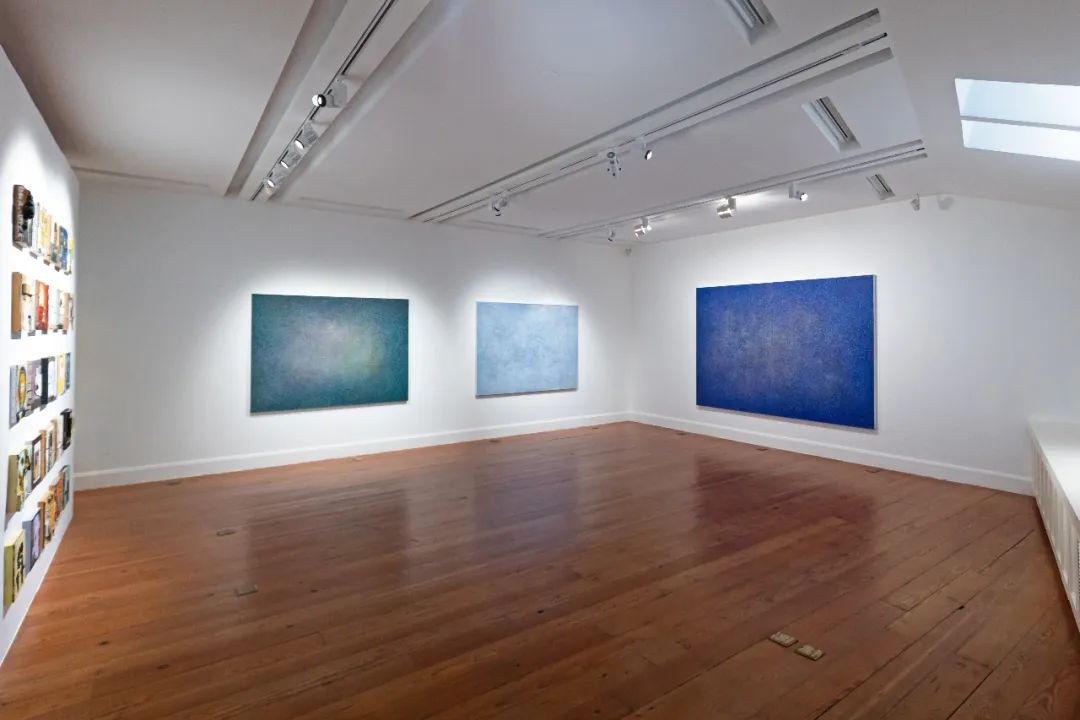
展览现场 Installation View
The Space of Painting: The Canvas, Studio, and Exhibition
Between San Francisco and Shanghai, Chen Kai pursued his passion for painting at the San Francisco Art Institute (SFAI) and worked for a residency program at the Headlands Center for the Arts. In 2023, Brown received an invitation to participate in Leo Gallery's residency program in Shanghai. On both sides of the ocean, artists have their own unique experiences and interpretations of foreign landscapes and cultures. These experiences become abstract elements in their paintings, strengthening the bond between the painters. Each artwork carries the information and beliefs of the artist, expressing their subjectivity. The artwork itself is a vessel that conveys emotions and evokes feelings – it cannot be possessed, but rather transitions into the next creation, maintaining an "unfinished" state. The studio, as a daily creative space for the painters, also acts as their refuge – bringing order to abstraction and embracing chaos or complexity. When viewers observe the paintings in the exhibition space, their own subjectivity is awakened. Within the realm of painting, the world remains tangible: the recent works of Brad Brown and Chen Kai resonate with each other but also retain distinct qualities, offering a vibrant blend of concepts and form that subtly and refreshingly embraces emotions.
©文章版权归属原创作者,如有侵权请后台联系删除